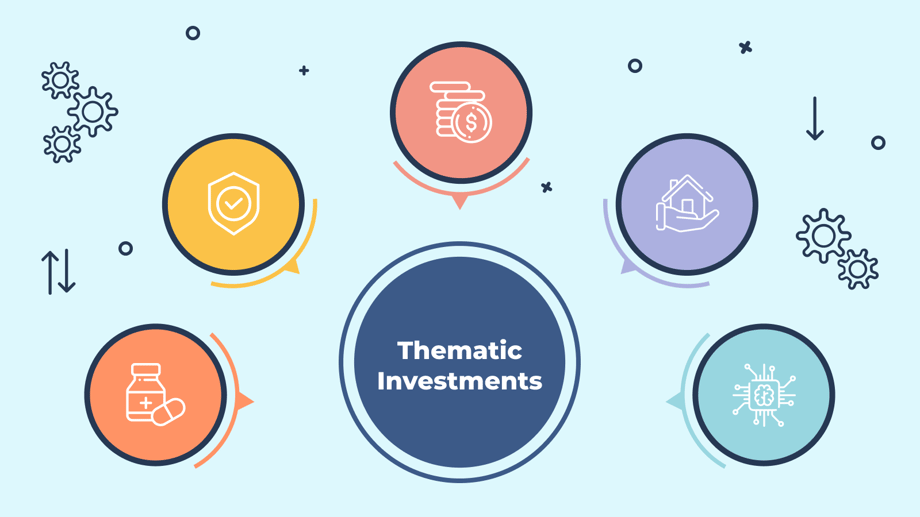Contents
Thematic Investing – What is it & Why Should Investors Care About It?
3 minutes read
13 May 2024

There are several companies whose services and products influence our lives or whose missions align with our beliefs. We often hear things like electric vehicles are the future, or that the renewable energy sector will have substantial growth. When it comes to investing though, there may be multiple companies that match our belief and we may find it challenging to pick a stock within that sector to invest in. For example, you may like clean energy but don’t know which company would outperform in that sector. If you have been in such a situation, thematic investing may be the answer.
What is Thematic Investing?
Thematic investing is an investing method where you identify significant opportunities or invest in popular trends without extensive research on individual stocks. For instance, if you believe electric vehicles will have a strong growth in the coming years, you can choose to invest in a theme designed explicitly with that view.
Most investors do not have efficient equity portfolios despite having the right investment approach because of the lack of expertise and time. Thematic investing may solve this problem and allows you to invest in different and specialized sectors that can offer concentrated exposure in line with your beliefs.
How Thematic Investing Works?
Even though thematic investing reduces the effort required to select individual companies, it is prudent to study and research the theme you are interested in and benchmark its risk and performance against the market. For your thematic investment strategy, you may choose to create a portfolio manually or select from the many thematic investment ETFs.
Steps to build a thematic portfolio manually:
1. Discovering Themes and Categories:
You can choose to invest in themes that echo your beliefs or select innovative trends that are gaining popularity. For example, you may want to invest in Fintech companies across the world, or in Robotics/AI companies in the US. Even broader sectors like Emerging Markets also fall under thematic investments. As a first step you filter out the themes that interest you.
2. Research and Decision:
Research different themes and sectors, compare and benchmark them against other asset classes. While benchmarking, make sure you also compare the risk (volatility) of the theme against the market. You can then proceed to configure the portfolio as per your preferences and risk profile.
3. Managing Weights:
You may consider a market-cap-weighted or risk-weighted distribution of stocks/ETFs in the theme. However, depending on your risk appetite, you may shuffle around and customize your portfolio.
4. Rebalance:
It is common to rebalance your portfolio periodically to generate optimum returns and balance risk. As the constituent performance diverges, you should update your portfolio to align the weights to the initial strategy. The idea is to ensure that the stock portfolio always tracks the underlying theme.
You may also get exposure to thematic investments through ETFs that invest in a particular theme or sector. For example, the Vanguard ESG U.S. Stock ETF (ESGV) allows investors to get exposure to ESG investing. ETFs’ benefit is that you don’t have to worry about deciding the weights of stocks or rebalancing. There is less flexibility on the flip side, and you cannot remove a stock that you may not like.
Benefits of Thematic Investing
One of the strengths of thematic investing is that it is much more concentrated compared to passive or regular fund strategies. For example, mutual funds typically invest in 50-80 stocks in a portfolio and the focus is on portfolio diversification meaning returns are compromised for keeping a lower risk.
Thematic investing focuses on a smaller pool of stocks to capture future trends and capitalize on potential growth. Selecting a few companies involved in renewable energy, blockchain, or the Internet of Things could yield better results, should those industries grow as expected. For instance, while S&P500 has increased by 15.8% in the last year, BOTZ ETF which invests in Robotics & Artificial Intelligence companies around the world has increased by over 45% in the same period. It is one of the notable examples of thematic investing strategies with long-term growth potential.
While thematic investments are concentrated in a sector, they offer a diverse exposure compared to investing in only 1 stock. You can also further reduce risk by creating a portfolio of multiple themes.
How to Make Thematic Investments
As mentioned earlier, ETFs are a great way of investing in different themes. Winvesta offers over 900 ETFs capturing multiple themes and categories. For example, if you are interested in country-specific ETFs, there is SPY that tracks the S&P500 Index (US), or DAX that tracks Germany’s stock market.
There are also many thematic ETFs such as FINX that invests in Fintech, BOTZ that invests in robotics/AI, and ICLN that provides exposure to renewable-energy focused stocks.
Conclusion
Thematic investing is all about emerging opportunities and structural shifts that can offer better returns or intangible satisfaction to the investor. You should regularly monitor and assess your portfolio to generate optimum returns and maintain a balanced risk.
Disclaimer: Please note that past performance is not a guide to future returns and that your capital is at risk.



